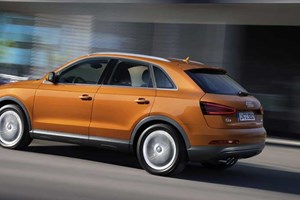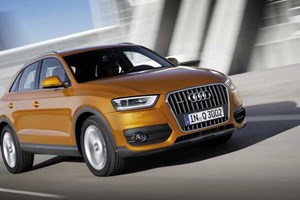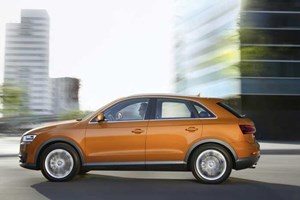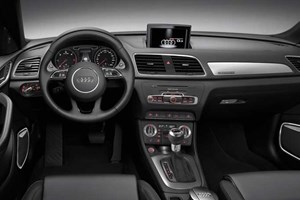This is the new Audi Q3, Ingolstadt’s rival for the BMW X1 and the forthcoming Range Rover Evoque. It’s the smallest Q-series 4x4 yet from Audi, and (at least initially) is only available with a selection of 2.0-litre, four-cylinder, turbocharged and direct-injection engines.
Items like an aluminium bonnet and aluminium bootlid are 50% lighter than the conventional steel items, there are big car options like 3D sat-nav complete with Google Earth tech, and let’s not forget the appeal of that four-ringed badge. The Q3 is already guaranteed to be a sales success for Audi, but is it any good? Read on for CAR’s first drive review of the new Audi Q3.
 Ah, I seem to remember an Audi concept car that looks like the Q3…
Ah, I seem to remember an Audi concept car that looks like the Q3…
That’ll be the Cross Coupe Quattro, unveiled way back in 2007; despite the huge array of new models that Audi has produced over the past few years, it’s actually taken a surprisingly long time for that small concept car to become a production reality.
In the metal and on the road it looks good, but only if you spec the S-line bodykit, and those LED headlamps and taillights too – and remember there’s a certain baby Range Rover on the way that’s rather stunning.
And inside?
Almost as good as you’d expect. I guess it’s a sign of how high Audi has set our expectations that, despite perceived quality easily being class leading and better than the equivalent BMW, you expect more of one or two of the plastics.
The seats don’t fold completely flat, but they do at least sit flush with the floor, there’s only a small lip over which to load your luggage, and one tall chap will comfortably sit behind another. Don’t expect to carry five adults in comfort though, and the raked C- and D-pillars limit the amount of light available to back seat passengers. There’s also a tiny, TT-alike oval rear-view mirror that’s just too small.
How does the new Audi Q3 drive?
Good points first. In terms of refinement, the Q3 is very good indeed – at motorway speeds there’s barely any wind noise, and what road roar there is is only apparent because everything else is so hushed.
Cars equipped with the S-tronic transmission (standard on the top-spec petrol and diesel) and the optional Drive Select system get a nifty de-coupling clutch that disengages the engine on the overrun. It works well: the gear indicator between the two dials disappears to indicate what’s going on and the engine’s revs drop to below 1000rpm nearly every time you back off the throttle. The only downside is the lack of engine braking; just as a Cayenne Hybrid in its ‘sailing’ mode can start to freewheel and pick up pace, the same is true of the Q3 so you actually need to keep your foot on the brake.
But…?
Let’s break it down by model. First, the top-level, 174bhp 2.0 TDI with Quattro and S-tronic as standard. There’s too much initial slack in the steering, after which it’s utterly lifeless. The Drive Select system’s Dynamic setting adds weight, but it feels too artificial and without the slickness that pervades in the new A6 and A7. There’s a large amount of initial body roll too, despite looking good the leather seats lack decent side support, and even the most vaguely enthusiastic driving around the odd hairpin will induce understeer and tyre squeal.
This hi-po diesel is a little too vocal as well, the stop/start system steadfastly refused to work during our test, and while the primary ride is good, it’s the smaller imperfections that trouble the Q3. It’s okay, but as ever, we need to drive the Q3 on UK roads to see how sorted the suspension really is.
Okay, so what about the other engines?
The front-drive, 138bhp version of the 2.0-litre diesel is much better. Without the weight of Quattro (or S-tronic) it’s keener to turn in, more agile, and there’s not enough power to ever really trouble the front wheels. Worried about the winter weather? Then use the cash you saved to buy a set of winter tyres; your car will be better in the snow and cold than a four-wheel drive Q3 on summer tyres, and you’ll get the mpg benefits of having just two driven wheels.
Ah, wheels. Our test car rode on 17-inch wheels (which will be standard in the UK) but the difference in ride quality between the 18in-shod 174bhp car was negligible. However the stop/start system was definitely better: it shut down at every set of lights, and gently winds back the air-con to keep the engine off while at least keeping the cabin reasonably cool. It then cranks the system back up once the engine restarts. The manual gearbox has a light throw, is a little notchy, but brings some welcome levels of interaction, the steering is a little sharper, and the fabric seats do a better job of holding you in place. It’s a much more honest, appealing package.
And the petrol engines?
The two variants of the 2.0 TFSI engine will account for just 15% of UK sales – blame fuel consumption figures in the mid-30s and CO2 emissions too close to 180g/km. That detrimental data notwithstanding, both are decent engines, strong on torque and keen to rev; the higher-power 208bhp version is a little louder, coarser and more obviously turbocharged.
There’s only 20kg difference between the top-level petrol and diesel engines in all-singing, all-dancing S-tronic and Quattro trim, but the 208bhp unit (and the lesser 168bhp version) felt more agile than the oilers, with improved steering too.
However, by far the best version CAR tried was the most irrelevant one. Audi had a couple of early versions of its hot Q3 on hand to test: this mad SUV runs the turbocharged 2.5-litre five-cylinder engine from the TT RS and RS3, and although it doesn’t have the full 335bhp (reckon on around 300bhp) the 332lb ft torque figure is identical.
Kitted out in S-line trim, with bright blue paint and big 19in wheels, it looked great. And it drove very well too. With no Drive Select system on these pre-pro cars, the steering was the best of all the Q3s we tried, much more linear and consistent. Of course the bigger wheels, and lowered, stiffer suspension mean a deterioration in ride quality, but the payoff is much better body control. And just as in the TT RS and RS3, the five-pot engine’s character dominates – there’s a wonderful burble and a lovely howl as you home in on the redline.
Verdict
Cabin quality, refinement, all the usual things that appeal about Audis, are present and correct in the Q3. Disregard the petrol engines and it’s a case of less is more though: the entry-level 138bhp 2.0 TDI is by far the best model. Audi’s marketing department is pushing for a front-wheel drive version of the 174bhp diesel, but the engineers are against it, so for now you’re best off buying the most basic Q3.
source : http://www.carmagazine.co.uk













0 komentar:
Post a Comment